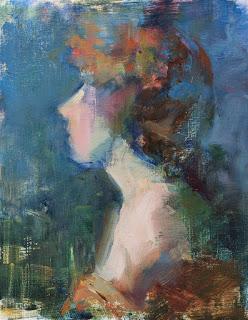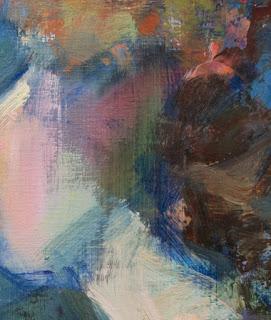
Some studio days are given over to experimentation: painting with no aim or gallery in mind, just seeing what comes out.
Yesterday I spent some time working with a new medium: Rublev's Epoxide Oil Gel. It's thixotropic - the new word of the day - which means that it flows while you're moving the brush and stops dead when the brush does. This, and it's rather sticky consistency, allows me to make visible brushmarks, even in colours that contain very little white. Because I avoid all the smelly alkyd mediums in my studio, this is a big deal. This gel acts somewhat like an alkyd gel (though it's stickier) but it's made out of "reinforced" linseed oil (don't ask me) and so has no smell or associated health issues. Like the alkyd gels, it transparentizes the paint and increases gloss. I'm not a huge gloss fan, but found that if I used it sparingly, it wasn't too shiny for my liking. That took some concentration because I'm not a "sparing" painter.
What really appealed to me was the ability to create lots of gooey, juicy layering and texture with both the brush and the knife while working alla prima. The transparency means that there's a greater variety of effects than would be possible with just paint, or paint and my usual 50/50 oil and OMS mixture.

This detail shows the nice, broken effects possible when just a little is mixed into the paint (in the pink and green of the face), as well as the thixotropic effect in orange mark at the top. Notice how that piece of orange froze into place and left a nice heavy mark, but picked up again as I dragged it across to the right. The edges of the initial mark are richly coloured and don't feel meagre, but still have the fine, hairy quality of a soft-brush application. Those of you who've used mongoose brushes know exactly what I mean. So I can get soft brush edges and layering while using a lot of paint and my beloved hog bristles.
Overall, I like it. This isn't an ideal gel, by any means, but it's the first solvent-free gel that I've used that doesn't feel greasy and too slippery. If anything, it suffers from being too sticky, but I feel that if I slow down my marks - as if I were using pure stand oil, for example - I can make it do interesting things. I can also add a bit of OMS to it to increase its flow a bit. I wouldn't add much, however, as that defeats the point of the medium. It's not meant to keep on flowing.
Like all mediums, you shouldn't use it in just one part of a painting or you'll risk cracking as different mediums create different drying times and conditions. So if you want to use it, start the painting with it. Because it's pure fat, you should follow the usual fat over lean rule and use it sparingly, or cut with OMS in the bottom layers and increase the amount that you add as you build. That happens naturally in alla prima painting because we always grab more paint volume as we build layers, but it's something that you have to be more conscious of if you let the work dry in between layers. Remember how much you were adding, and how much paint you were laying down, and do more of both in the next layer when you start the painting up again.
I'm also playing around with Rublev's Impasto Putty and will let you know if it holds any revelations.
Happy painting!

